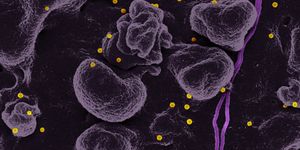Digital Oculus Sees Diseased Cells Like Never Before
A picture may be worth a thousand words, but it may be worth a lot more with advanced image analysis technologies. A team of researchers at the Medical College of Georgia at Augusta University have developed TDAExplore—a new image analysis pipeline that combines microscopy, mathematics, and artificial intelligence to provide never-before-seen insights on how cells change as a result of the disease.
Part of why TDAExplore is so powerful is that it’s accessible and can be used on a laptop to gather rich insights from images captured by microscopes or even other diagnostic imaging techniques such as X-rays and PET scans.
One of the lead developers of the technology, Eric Vitriol, says that this empowers users to identify how images from healthy cells and diseased ones differ. “What are the actual biological changes that are happening, including ones that I might not be able to see, because they are too minute, or because I have some kind of bias about where I should be looking,” commented Vitriol.
It’s not just objectivity that so-called computer vision offers, but also the volume of data that they can process at any given moment. In TDAExplore, for example, the platform recognizes how fibers, filaments, and other cell features move or change from image to image. It’s able to do this without hundreds of ‘training’ images (as previous iterations of such technologies have relied on). Instead, TDAExplore learns to differentiate between healthy and disease using as few as 20 to 25 images.
Vitriol says the data gathered from such AI-powered platforms can transform how diseases are diagnosed. Every pixel of diagnostic images holds subtle clues on disease pathology, which can now be extracted and used to drive clinical insights.
“TDAExplore is therefore an accessible, powerful option for obtaining quantitative information about imaging data in a wide variety of applications,” wrote the authors.


![[Guide] 7 Strategies to Boost Laboratory Collaboration](https://d3bkbkx82g74b8.cloudfront.net/eyJidWNrZXQiOiJsYWJyb290cy1pbWFnZXMiLCJrZXkiOiJjb250ZW50X2FydGljbGVfcHJvZmlsZV9pbWFnZV83YzBjZWIwM2Y5YzI4MmFlYzBhZDZhMTcyNTQ1ZGU3YmE4Y2MzMDYyXzUxNDkuanBnIiwiZWRpdHMiOnsidG9Gb3JtYXQiOiJqcGciLCJyZXNpemUiOnsid2lkdGgiOjcwMCwiaGVpZ2h0IjozNTAsImZpdCI6ImNvdmVyIiwicG9zaXRpb24iOiJjZW50ZXIiLCJiYWNrZ3JvdW5kIjoiI2ZmZiJ9LCJmbGF0dGVuIjp7ImJhY2tncm91bmQiOiIjZmZmIn19fQ==)






